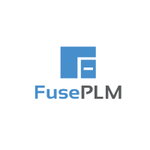Best Product Lifecycle Management (PLM) Software
Best PLM software companies in India are Upchain PLM, Arena, Teamcenter Siemens, Autodesk Fusion Lifecycle, and Windchill. These PLM tools automate and standardize the product development lifecycle.



No Cost Personal Advisor
List of 20 Best PLM Software
Emergents | 2024
Complete suite of SCM and Manufacturing
Enterprises can respond swiftly to changing demand, supply and market conditions with Oracle Fusion Cloud SCM. Transform your business operations by optimizing order, supply and fulfillment in a single view. Learn more about Oracle Fusion Cloud SCM
Explore various Oracle Fusion Cloud SCM features, compare the pricing plans, and unlock the potential of seamless operations by selecting the right software for your business.
- Purchase Order
- Purchasing & Receiving
- Supply Chain Management
- Bill of materials (BoM)
- Order Processing
- Maintenance Management
- Contract Management
- Inventory Management
Oracle Fusion Cloud SCM Caters to
- StartUps
- SMBs
- Agencies
- Enterprises
Emergents | 2024
Software by productboard, Inc
Product board is an excellent product management tool that helps you understand the user needs, prioritize what to build, & rally everyone around your roadmap. It surfaces the future ideas & confidently decides what to build next & share with the team. Learn more about productboard
Explore various productboard features, compare the pricing plans, and unlock the potential of seamless operations by selecting the right software for your business.
Features
View all productboard Features- Feedback Collection
- Resource Management
- Reporting
- Product Roadmapping
- Workflow Management
- Milestone Tracking
- Collaboration
- Release Management
Pricing
New Idea
$ 49
Per Month
Startup
$ 99
Per Month
productboard Caters to
- StartUps
- SMBs
- Agencies
- Enterprises
Emergents | 2024
Software by Propel
The Propel PLM is a one of the most popular cloud-based Product Life-Cycle Management System. Its modules provided for Product Record, Bill of Materials, Configuration Management, Product Quality, and so on. It is simple to using workflow manage for engineering changing, included ECOs, CAPAs, and NCMRs and to manage project tasks and deliverable. Learn more about propel
Explore various propel features, compare the pricing plans, and unlock the potential of seamless operations by selecting the right software for your business.
Features
View all propel Features- Bill of materials (BoM)
- Manufacturing Process Planning
- Portfolio Management
- Data Security
- Centralized Management
- Compliance Management
- Collaboration
- Change Management
Pricing
Everyone
$ 45
User/Month/Billed Annually
Essential
$ 90
User/Month/Billed Annually
Enterprise
$ 120
User/Month/Billed Annually
propel Caters to
- StartUps
- SMBs
- Agencies
- Enterprises
Contenders | 2024
Software by Siemens PLM Software
Siemens PLM Software is a major global provider of product lifecycle management (PLM) and manufacturing operations management (MOM) software. This PLM product management system information that can integrate data, processes, business systems and, ultimately, people in an extended enterprise. PLM software providers to manage information throughout all lifecycle of a product efficiently and cost-effectively. Read Siemens PLM Reviews
Explore various Siemens PLM features, compare the pricing plans, and unlock the potential of seamless operations by selecting the right software for your business.
Features
View all Siemens PLM Features- Product data management
- Bill of materials (BoM)
- Reporting
- Compliance Management
- Design Management
- Supplier Management
Siemens PLM Caters to
- StartUps
- SMBs
- Agencies
- Enterprises
Contenders | 2024
Software by New Relic
New Relic is an APM monitoring tool for software developers and IT professionals. This program offers memory usage optimization, CPU utilization, code profiling, database query performance, web browser rendering performance, and error analysis features. Read New Relic Reviews
Explore various New Relic features, compare the pricing plans, and unlock the potential of seamless operations by selecting the right software for your business.
Features
View all New Relic Features- Root-Cause Diagnosis
- Full Transaction Diagnostics
- Resource Management
- Baseline Manager
- Real Time Monitoring
- Uptime Reporting
- Transaction Monitoring
- Event Logs
New Relic Caters to
- StartUps
- SMBs
- Agencies
- Enterprises
Emergents | 2024
Software by Aras
Aras PLM (Product lifecycle management) is highly flexible, scalable, and upgradeable software for all size of business. This system working across functions and supply chain partners. Aras PLM software allows organizations to efficiently collaborate to optimize resources, minimize costly errors, and reduce time to market and increased profitability. Learn more about Aras PLM
Explore various Aras PLM features, compare the pricing plans, and unlock the potential of seamless operations by selecting the right software for your business.
Features
View all Aras PLM Features- ALM Integration
- PDM Integration
- Collaboration
- Design Management
- Configuration Management
- Portfolio Roadmap
- Data Security
- Product Specs
Aras PLM Caters to
- StartUps
- SMBs
- Agencies
- Enterprises
Emergents | 2024
Software by PTC Inc.
PTC software is Product Lifecycle Management solution. It helps to you manage cross-functional processes, coordinating the efforts of distributed teams and efficiently develop the best possible products. PTC software optimizing product development processes and using a single, secure source of information, you can develop products that are competitive, cost-effective, and high quality. Read ptc Reviews
Explore various ptc features, compare the pricing plans, and unlock the potential of seamless operations by selecting the right software for your business.
Features
View all ptc Features- Customer Feedback
- Change Management
- Compliance Management
- Reporting
- Design Management
- Document Management
- Collaboration
- Product data management
ptc Caters to
- StartUps
- SMBs
- Agencies
- Enterprises
Contenders | 2024
Software by Oracle Corporation
Agile PLM is a fully featured PLM Software designed to serve Agencies, SMEs. Agile PLM provides end-to-end solutions designed for Windows. This online PLM system offers Requirements Management, Cost Tracking, Design Management at one place. Read Oracle Agile PLM Reviews
Explore various Oracle Agile PLM features, compare the pricing plans, and unlock the potential of seamless operations by selecting the right software for your business.
Features
View all Oracle Agile PLM Features- Design Management
- Requirements Management
- Cost Tracking
Oracle Agile PLM Caters to
- StartUps
- SMBs
- Agencies
- Enterprises
Emergents | 2024
Software by Arena Solutions
Arena PLM is a colud-based application. This application help to the business activity of managing a company's products. This product use for sharing product information, companies design, produce and improve new products. Learn more about Arena PLM
Explore various Arena PLM features, compare the pricing plans, and unlock the potential of seamless operations by selecting the right software for your business.
Features
View all Arena PLM Features- Cost Tracking
- Design Management
- Compliance Management
- Change Management
- Product data management
- Data Security
- Document Management
- Project Management
Pricing
Average Price
$ 89
User/Month
Arena PLM Caters to
- StartUps
- SMBs
- Agencies
- Enterprises
Emergents | 2024
Software by Infor
Infor PLM is easy to use and affordable Product lifecycle management software for small-medium size manufacturing Industries. Using this system you can optimize every step of the product lifecycle to create higher quality products, launch new products in less time at a lower cost and maximize profits. Learn more about Infor PLM
Explore various Infor PLM features, compare the pricing plans, and unlock the potential of seamless operations by selecting the right software for your business.
Features
View all Infor PLM Features- PDM Integration
- Idea Management
- Product lifecycle intelligence
- Collaboration
- Product data management
- ALM Integration
- Data Security
- Change Management
Infor PLM Caters to
- StartUps
- SMBs
- Agencies
- Enterprises
Emergents | 2024
Software by Centric Software
Centric PLM V6.2 is a fully featured PLM Software designed to serve Startups, SMEs. Centric PLM V6.2 provides end-to-end solutions designed for Windows. This online PLM system offers Cost Tracking, Compliance Management, Change Management, Design Management, Product data management at one place. Learn more about Centric PLM V6.2
Explore various Centric PLM V6.2 features, compare the pricing plans, and unlock the potential of seamless operations by selecting the right software for your business.
Features
View all Centric PLM V6.2 Features- Supplier Management
- Product data management
- Design Management
- Change Management
- Cost Tracking
- Compliance Management
Centric PLM V6.2 Caters to
- StartUps
- SMBs
- Agencies
- Enterprises
Emergents | 2024
Software by Upchain
Upchain is a fully featured PLM Software designed to serve Enterprises, Agencies. Upchain provides end-to-end solutions designed for Windows. This online PLM system offers Requirements Management, Supplier Management, Project Management, Change Management, Cost Tracking at one place. Learn more about Upchain
Explore various Upchain features, compare the pricing plans, and unlock the potential of seamless operations by selecting the right software for your business.
Features
View all Upchain Features- Requirements Management
- Product data management
- Cost Tracking
- Document Management
- Compliance Management
- Project Management
- Design Management
- Supplier Management
Upchain Caters to
- StartUps
- SMBs
- Agencies
- Enterprises
Emergents | 2024
Software by FusePLM
FusePLM is a fully featured PLM Software designed to serve Startups, Agencies. FusePLM provides end-to-end solutions designed for Windows. This online PLM system offers Document Management, Supplier Management, Requirements Management, Product data management, Change Management at one place. Learn more about FusePLM
Explore various FusePLM features, compare the pricing plans, and unlock the potential of seamless operations by selecting the right software for your business.
Features
View all FusePLM Features- Product data management
- Document Management
- Change Management
- Requirements Management
- Supplier Management
FusePLM Caters to
- StartUps
- SMBs
- Agencies
- Enterprises
Emergents | 2024
Software by aPriori
aPriori is a fully featured PLM Software designed to serve SMEs, Enterprises. aPriori provides end-to-end solutions designed for Windows. This online PLM system offers Cost Tracking at one place. Learn more about aPriori
Explore various aPriori features, compare the pricing plans, and unlock the potential of seamless operations by selecting the right software for your business.
Features
View all aPriori Features- Manufacturing Intelligence
- Quality Management
- Cost Tracking
- Product Lifecycle Management
- Simulation
- Computer-Aided Engineering (CAE)
aPriori Caters to
- StartUps
- SMBs
- Agencies
- Enterprises
Category Champions | 2024
Software by Atlassian
Jira is a issue tracking software, developed by Atlassian. It provides bug tracking, issue tracking, and project management feature for small, medium and large team. Read Jira Reviews
Explore various Jira features, compare the pricing plans, and unlock the potential of seamless operations by selecting the right software for your business.
Features
View all Jira Features- Status Tracking
- Deployment Management
- Collaboration
- Budget Management
- Scheduled / Automated Reports
- Project Planning
- Data Imports/Exports
- Private Dashboards
Pricing
Free
$ 0
Per Month
Standard
$ 8
Per Month
Premium
$ 15
Per Month
Jira Caters to
- StartUps
- SMBs
- Agencies
- Enterprises
Contenders | 2024
Full Suite of Integrated Business Apps
Odoo is a powerful open source ERP/CRM and comprehensive business applications and easy to Track leads. It has a rich web interface that is both feature rich and powerful that is highly customizable to suit your business requirements. You can also download it or grab the source code from GitHub. Read Odoo Reviews
Explore various Odoo features, compare the pricing plans, and unlock the potential of seamless operations by selecting the right software for your business.
Features
View all Odoo Features- Failed Transaction Management
- Access Controls/Permissions
- Cost Tracking
- Business intelligence (BI)
- Slick API
- Profitability Analysis
- Tax Forms
- Multi-User Collaboration
Pricing
Odoo
$ 20
User/Month
Odoo Caters to
- StartUps
- SMBs
- Agencies
- Enterprises
Emergents | 2024
Software by Roadmunk
Roadmunk is a fully featured Product Roadmap Software designed to serve SMEs, Enterprises. Roadmunk provides end-to-end solutions designed for Windows. This online Product Roadmap system offers Prioritization, Content Import / Export, Drag & Drop, Milestone Tracking, Feature Management at one place. Learn more about Roadmunk
Explore various Roadmunk features, compare the pricing plans, and unlock the potential of seamless operations by selecting the right software for your business.
Features
View all Roadmunk Features- Prioritization
- Requirements Management
- Collaboration
- Workflow Management
- Feature Management
- Drag & Drop
- Milestone Tracking
- Diagramming
Roadmunk Caters to
- StartUps
- SMBs
- Agencies
- Enterprises
Contenders | 2024
TEAMCENTER SEARCH MADE EASY
InteliSearch provides the most intuitive way to configure and search Teamcenter data. It is backed by a highly optimized search algorithm and a user friendly interface that not only reduces the time but also improves the efficiency of Teamcenter users. Read INTELISEARCH Reviews
Explore various INTELISEARCH features, compare the pricing plans, and unlock the potential of seamless operations by selecting the right software for your business.
Features
View all INTELISEARCH Features- Document Management
- API Integration
- Bill of materials (BoM)
- Product data management
- Customization
- Data Capture
- Reporting
INTELISEARCH Caters to
- StartUps
- SMBs
- Agencies
- Enterprises
Software by Siemens
Teamcenter is a fully featured PLM Software designed to serve SMEs, Agencies. Teamcenter provides end-to-end solutions designed for Windows. This online PLM system offers Design Management, Project Management, Requirements Management, Change Management, Supplier Management at one place. Read Teamcenter Reviews
Explore various Teamcenter features, compare the pricing plans, and unlock the potential of seamless operations by selecting the right software for your business.
Features
View all Teamcenter Features- Change Management
- Project Management
- Requirements Management
- Design Management
- Supplier Management
- Compliance Management
Teamcenter Caters to
- StartUps
- SMBs
- Agencies
- Enterprises
Contenders | 2024
We build project management culture for your enter
TouchBase offers project mgt solutions to Professional Services, Pharma, EPC, Engineering, etc. It supports business cases, proposals, NPD, schedule, resources, costs, procurement, risks, etc. It integrates with ERPs, CRMs, Accounting. Read Kytes Reviews
Explore various Kytes features, compare the pricing plans, and unlock the potential of seamless operations by selecting the right software for your business.
Features
View all Kytes Features- Approval Workflow
- Operational Risk Management
- Data Visualization
- Iteration Planning
- Reimbursement Management
- Vendor Management
- Report Export
- Call Management
Kytes Caters to
- StartUps
- SMBs
- Agencies
- Enterprises
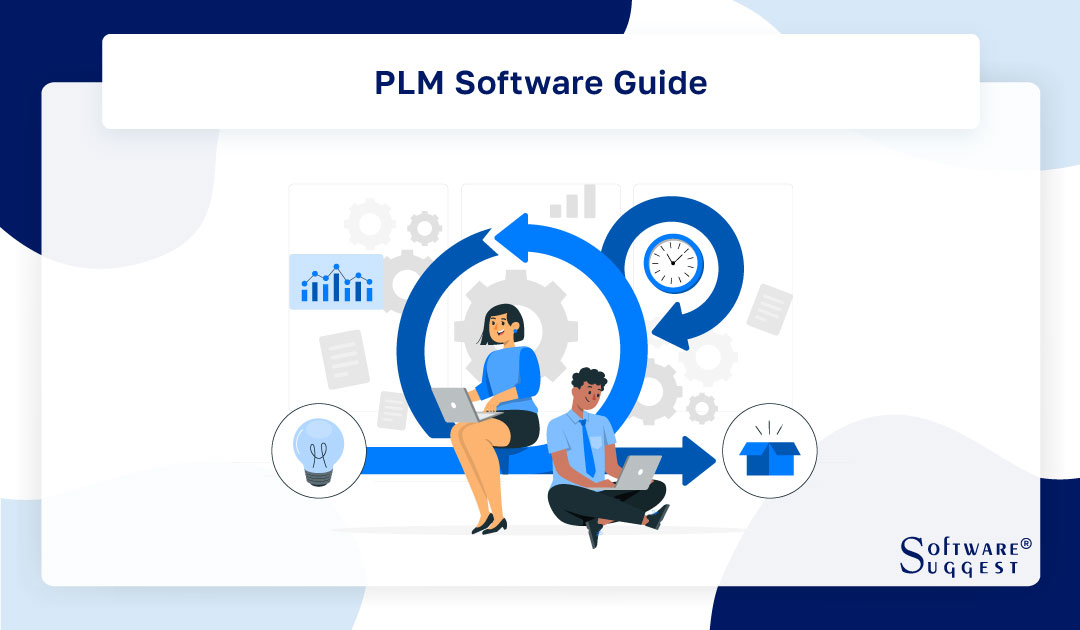
PLM software is an indispensable resource for businesses navigating the intricate landscape of product development. In a world of technological evolution, selecting the optimal PLM system is paramount. This guide serves as a meticulous compass, offering a comprehensive roadmap to align your organization's unique needs with cutting-edge PLM offerings.
Whether you lead an established enterprise or spearhead a startup, join us in this detailed narrative as we unveil the most sophisticated product lifecycle management software. Here, we bring expert opinions where precision and innovation converge. Thus propelling your products seamlessly from ideation to market excellence.
What Is Product Lifecycle Management (PLM) Software?
Product Lifecycle Management (PLM) software oversees a product's entire journey, from idea to disposal. It centralizes collaboration, information sharing, and decision-making for cross-functional product development teams. Imagine a product's journey as a lifecycle—from the moment it's conceived as an idea to its eventual retirement. The product lifecycle management system serves as the digital command center for this entire process.
It makes it easier for teams in charge of design, engineering, production, and other phases to work together and communicate smoothly. Product lifecycle management tools ensure that everyone involved has access to the latest information, track changes, streamline workflows, and enhance overall efficiency. By consolidating data and processes, PLM tools optimize product development, reduce time-to-market, and ultimately contribute to better product quality.
What's The Difference Between PLM Software and PDM Software?
PLM (Product Lifecycle Management) and PDM (Product Data Management) often swirl around, creating an air of confusion. While both are vital tools for efficient product management, it's crucial to understand their nuances. Let's see the PLM software comparison with PDM software in detail :-
-
Scope of management
PLM Software: Encompasses the entire lifecycle of a product, from its conceptualization and design to manufacturing, distribution, and end-of-life considerations. PLM is a holistic approach that integrates all aspects of product development and management.
PDM Software: Primarily focuses on managing and controlling product-related data during the design and engineering phases. PDM ensures that the right people have access to the right data at the right time, streamlining collaboration and version control within the design process.
-
Lifecycle vs. data-centric
PLM Software: Takes a broader view, considering the entire product journey. It goes beyond data management, incorporating processes, people, business systems, and external partners to optimize the product's entire lifecycle.
PDM Software: Centers on data and document management, concentrating on the creation, organization, and version control of product-related documents and files. It's more focused on the engineering and design aspects of a product's lifecycle.
-
Collaboration and cross-functional teams
PLM Software: Serves as a centralized hub that fosters collaboration among cross-functional teams involved in various stages of product development. It facilitates communication, decision-making, and information sharing across different departments.
PDM Software: Primarily facilitates collaboration within design and engineering teams. It ensures that everyone within these specific teams has access to the latest design data and documents. Thus enhancing internal communication, coordination, and quality management.
-
Business processes and workflows
PLM Solution: Integrates with and optimizes business processes across the entire organization. It provides tools to streamline workflows, manage changes, and ensure compliance with industry standards and regulations. Thus maintaining the entire product lifecycle.
PDM Software: Focuses on engineering workflows, providing tools for version control, access control, and the organization of design-related documents. While it contributes to efficiency within design processes, its scope is narrower than that of PLM.
-
Time-to-market and innovation
PLM solutions: Assists in reducing time-to-market by offering a comprehensive view of the product lifecycle. It facilitates innovation by connecting disparate elements and fostering an environment where creative ideas can seamlessly evolve into tangible products.
PDM software: Contributes to efficiency within the design and engineering phases, ensuring that these phases are well-organized and controlled. While it can enhance the design process, it may not directly impact broader business strategies related to the entire product lifecycle.
How Does A PLM System Work?
The best product lifecycle management software navigates a product's entire lifecycle, from inception to disposal. It automates crucial business processes, ensuring efficiency while also centralizing and organizing product data within a unified environment. Let's see the working of PLM software solutions:
-
Ideation and requirements gathering
In the ideation and requirements-gathering phase, the seeds of a product are planted. Stakeholders, including customers, engineers, and marketing teams, contribute to this foundational stage. Through collaborative brainstorming, the team collects insights, ideas, and essential requirements.
These inputs are meticulously documented for a comprehensive manufacturing process planning. This strategy serves as the blueprint that directs the following phases of the product lifecycle.
-
Product design
Guided by the product plan, the product design phase kicks in. This entails producing technical drawings, other design documents, and intricate 3D models. PLM companies play a pivotal role at this stage, serving as a centralized repository for all design-related data.
It ensures version control, accessibility, and collaboration among different design teams. Thus fostering an efficient and coherent design process in business systems.
-
Engineering and manufacturing
Once the design is complete, the focus shifts to engineering and manufacturing. The best PLM software takes the lead in generating critical manufacturing documentation, including bills of materials and work instructions.
It streamlines the transition from design to production by providing a centralized platform for managing and sharing manufacturing-related data. The PLM products also monitor the manufacturing process, identifying and addressing potential issues to ensure a smooth production flow.
-
Service and support
Post-product release, the top PLM software continues to play a crucial role in the service and support phase. It serves as a monitoring tool, tracking the product's performance in the hands of customers. In case of issues or the need for support, PLM software companies facilitate efficient problem-solving.
It does this by providing access to relevant data. Moreover, PLM software vendors assist in the creation and management of service manuals and support documentation. Hence contributing to a seamless post-sales support experience.
-
Retirement and disposal
As a product approaches the end of its lifecycle, the top PLM systems remain an essential asset. It facilitates the tracking of retirement and disposal processes. Thus ensuring compliance with regulatory requirements. Additionally, the best PLM systems generate reports on the environmental impact of the product.
Thus contributing valuable insights into sustainable practices. By providing a comprehensive overview of the product's lifecycle, the product lifecycle management system supports responsible product management from inception to retirement.
Who Uses PLM Software Tools?
PLM software has become a cornerstone for various industries. Its versatility makes it a valuable tool for organizations across different sectors. Let's delve into specific industries to understand how PLM software tools cater to their unique needs.
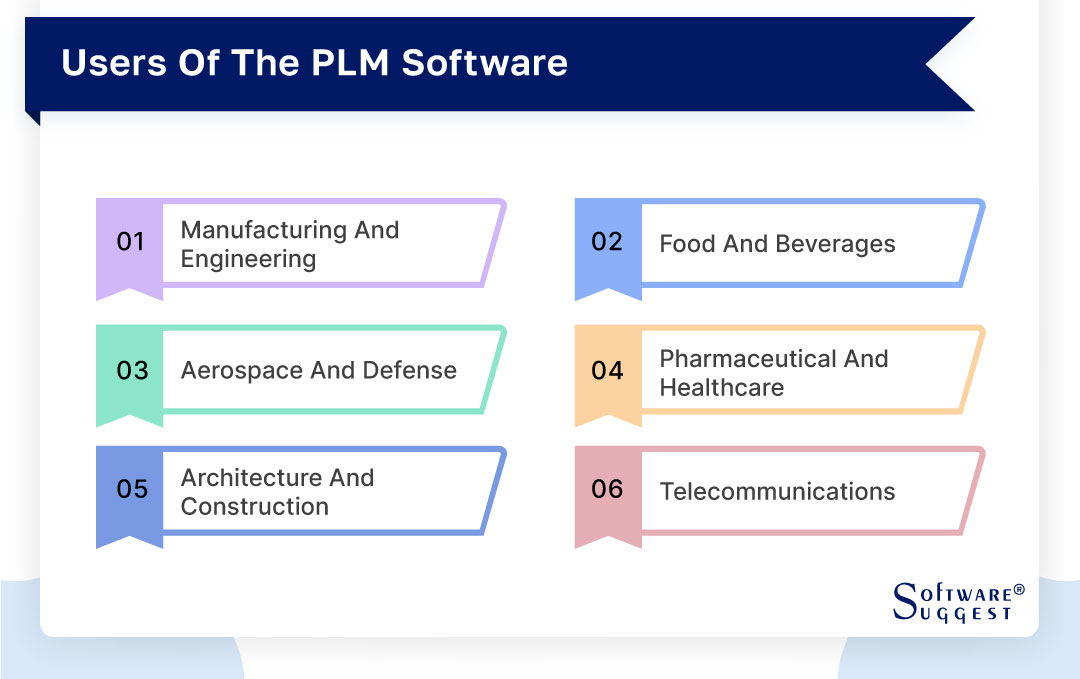
-
Manufacturing and engineering
For manufacturing and engineering sectors, PLM is the linchpin that streamlines intricate processes and integrates seamlessly with supply chain management. From concept to production, PLM tools facilitate collaborative design, ensuring that all stakeholders are on the same page.
The software helps manage complex bills of materials (BOMs), supports version control, and tracks change in real-time. The synergy between PLM and supply chain management enhances overall operational efficiency and collaboration across the product development lifecycle.
-
Food and beverages
In the food and beverages industry, where innovation and compliance are paramount, PLM tools play a crucial role. These tools manage recipe formulation, ingredient specifications, and regulatory compliance, ensuring that products meet safety standards.
Additionally, PLM enhances collaboration among teams involved in product development. Consequently, business resource planning and innovation are encouraged while maintaining compliance with quality and safety standards.
-
Aerospace and defense
In the aerospace and defense sector, precision and compliance are non-negotiable. PLM tools are instrumental in managing complex design data. It ensures regulatory compliance and facilitates collaboration across geographically dispersed teams.
This cloud PLM solution assists in the creation and management of detailed technical documentation. Hence encouraging the creation of innovative technologies that adhere to strict quality and safety standards.
-
Pharmaceutical and healthcare
In pharmaceutical and healthcare industries, where product safety and regulatory compliance are paramount, PLM software ensures meticulous management of product data. It facilitates the creation and tracking of detailed product specifications and manages regulatory documentation.
Also, it ensures that changes are seamlessly integrated. PLM tools contribute to the speedier development of new medications, adherence to compliance standards, and efficient lifecycle management of healthcare products.
-
Architecture and construction
PLM tools are increasingly finding applications in architecture and construction. These tools manage design data for building projects, supporting collaboration among architects, engineers, and contractors.
They help in version control of architectural plans, project timelines, and resource allocation. Thus ensuring that construction projects proceed smoothly and meet computer aided design specifications.
-
Telecommunications
In the fast-paced world of telecommunications, PLM tools are indispensable for managing the lifecycle of hardware and software products. These tools help in designing and optimizing network infrastructure, managing product specifications, and ensuring quality control with evolving technologies. PLM in telecommunications contributes to faster product development cycles, efficient change management, and improved collaboration among diverse teams.
What Are The Benefits Of The Best PLM Software?
The importance of PLM software in the business landscape is escalating, with organizations seeking avenues to enhance productivity, collaboration, and innovation. Now, let us analyze the main benefits that top PLM software offers.

-
Centralized data management
The capacity to efficiently organize and centralize data is at the core of PLM software. The best inspection software serves as a unified repository for all product-related information, from design specifications to manufacturing processes.
This centralized approach ensures that all stakeholders, regardless of their location, have access to the latest and most accurate data. This lowers the possibility of mistakes and improves teamwork by giving all participating teams a single source of truth.
-
Enhanced product development
PLM software is a game-changer in product development. It streamlines the entire process, from the conceptualization of an idea to its realization. Manufacturing software provides a collaborative platform for design, engineering, and other cross-functional teams.
Also, PLM ensures that everyone is aligned with the project goals. This collaboration minimizes delays, accelerates decision-making, and fosters a more iterative and efficient product development cycle.
-
Risk reduction
In making products, there are many risks, like changing designs, following rules, or problems in getting materials. The best PLM software acts as a risk mitigation tool by providing visibility into all stages of the product lifecycle. This transparency enables teams to identify potential risks early in the process, allowing for proactive measures and minimizing the impact on timelines and budgets.
-
Improved employee communication
Effective communication is the lifeblood of successful product development, and PLM software excels in facilitating this crucial aspect. PLM provides a centralized platform for collaboration, ensuring that team members are working from the same understanding.
It not only lessens the possibility of miscommunications but also promotes a shared knowledge culture. When people from different departments share their thoughts, it helps the team understand the product and its needs much better.
-
Faster time-to-market
Time is often a critical factor in the competitive landscape, and the best quality management software is designed to expedite time-to-market. By streamlining workflows, reducing manual errors, and providing real-time insights, PLM enables organizations to bring products to market more swiftly. This not only enhances competitiveness but also allows establishments to capitalize on market trends and customer demands in a more timely manner.
-
Innovation and ideation
Innovation is crucial for long-term success, and resource management software is the key. It creates a collaborative space for teams to share, tweak, and experiment, fostering a culture of constant improvement.
The best PLM solutions don't just assist with current processes; they also spark creativity. In doing so, they keep their companies at the forefront of their respective industries and open the door for ground-breaking innovations.
What Are The Features of the Best PLM Tools?
The features of the best product lifecycle management tools play a pivotal role. These tools go beyond basic functionalities, enhance decision-making, and foster innovation. Let's delve into the key features that distinguish the best PLM tools in the market.
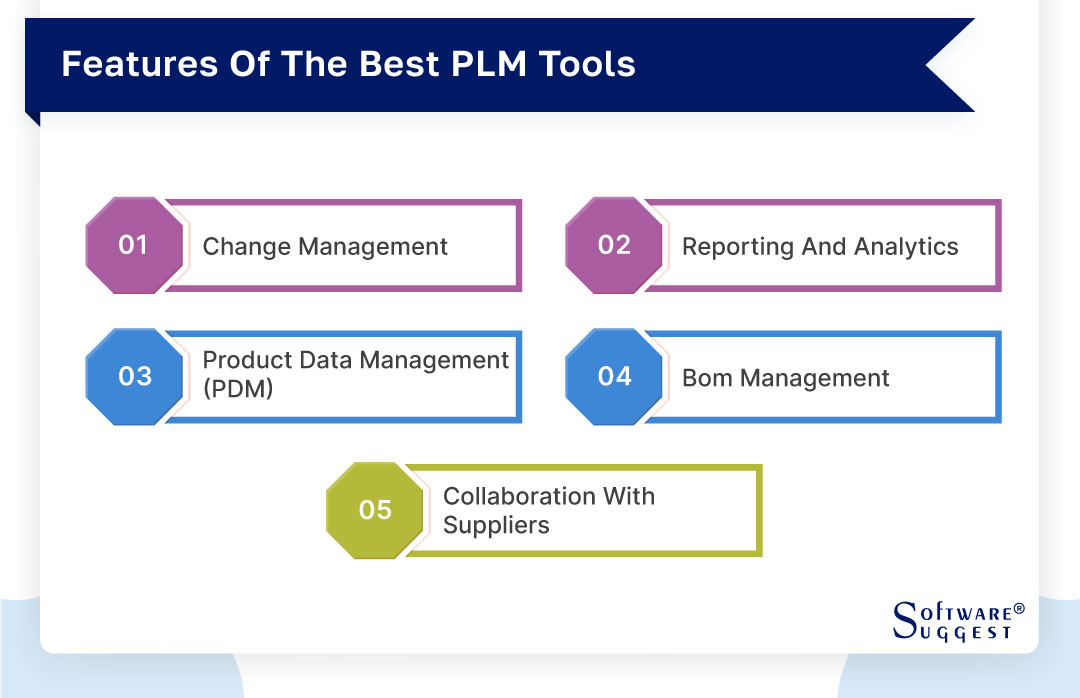
-
Change management
Change is inevitable in the iterative process of product development. The best PLM tools incorporate robust change management capabilities to ensure that modifications to designs, specifications, or processes are seamlessly integrated.
These tools provide a systematic approach to document, review, and implement changes. Thus allowing teams to adapt swiftly while maintaining the integrity of the product and its documentation. Effective change management is critical for avoiding errors, ensuring compliance, and expediting the product development lifecycle.
-
Reporting and analytics
Informed decision-making is the bedrock of successful product management. The best PLM tools offer robust reporting and analytics features that provide valuable insights into various aspects of the product lifecycle.
From tracking project progress to analyzing the performance of different product iterations, these tools empower teams with data-driven decision-making capabilities. Because real-time analytics can spot patterns, possible hazards, and opportunities for improvement, they boost operational efficiency and help in strategic planning.
-
Product data management (PDM)
Central to PLM functionality is product data management (PDM), a feature that ensures efficient organization, storage, and retrieval of product-related information. The best production management software acts as a centralized repository for design documents, technical specifications, and other critical data.
Version control is streamlined by PDM, reducing the possibility of mistakes brought on by out-of-date data. Regardless of their positions within the product development process, all stakeholders have access to a single source of truth due to this feature, which improves collaboration.
-
BOM management
Bill of Materials (BOM) management is a fundamental aspect of product development, especially in manufacturing. The best material management software excels in BOM management by offering tools to create, organize, and manage complex BOM structures.
This special feature ensures that all the different parts and pieces are documented correctly. It helps the design and production teams talk to each other better.
-
Collaboration with suppliers
Product development success frequently depends on suppliers working well together. The best PLM tools extend their reach beyond organizational boundaries. Thus providing features that facilitate seamless collaboration with external partners, vendors, and suppliers.
These tools offer secure platforms for sharing design data, specifications, and project updates, fostering a collaborative ecosystem. Improved communication with suppliers ensures that everyone involved in the supply chain is aligned with project goals. Thus leading to smoother production processes and timely deliveries.
How To Select The Right Product Lifecycle Management (PLM) Software?
Let's navigate the diverse landscape of PLM software, which requires a strategic approach. This section explores key selection criteria, from industry-specific needs to usability, ensuring a tailored selection process. Let's see in detail:
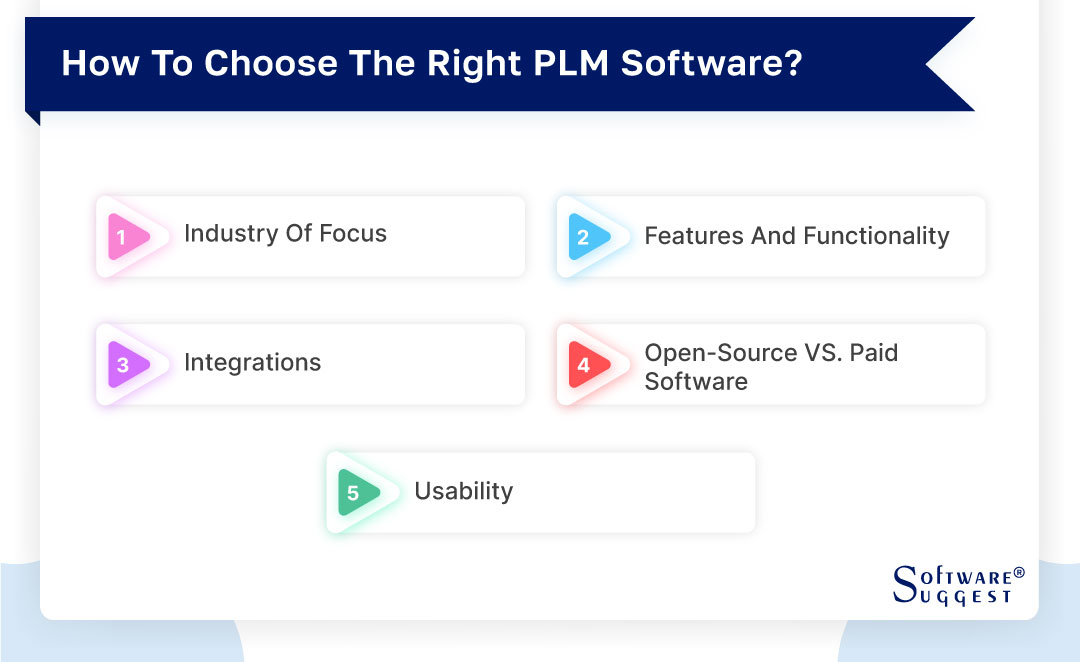
-
Industry of focus
Selecting the right PLM software begins with a comprehensive understanding of the industry in which your business operates. PLM software, from creation to disposal, is intended to simplify procedures. Standards for compliance and specific criteria vary throughout industries.
Start by determining the main difficulties and problems unique to your sector. Are there strict regulatory compliance standards? Does the industry demand rapid innovation and shorter time-to-market cycles? Knowing these industry-specific nuances helps in narrowing down PLM solutions that align with your business goals.
-
Features and functionality
The PLM software list comes with a wide array of features, and it's crucial to align these with your business objectives. Start by listing the essential functionalities your business requires. This could include document management, product data management (PDM), collaboration tools, change management, and quality management.
Think about how scalable the PLM solution is. As your business grows, the software should be able to accommodate more users, data, and complexity. Additionally, look for components that promote departmental and even external partner collaboration. A smooth workflow also depends on the integration of ERP and PLM systems.
-
Integrations
Efficient integration capabilities are pivotal for a successful PLM implementation. The program ought to combine with your establishment's current tools and systems without any problems. By doing away with manual data entry, this integration not only lowers the learning curve for users but also improves data accuracy.
Consider how well the PLM solution integrates with other critical systems such as CAD (Computer-Aided Design) software, ERP software, and manufacturing execution systems. This ensures that data flows seamlessly across the entire product development and production cycle. Hence reducing errors and improving efficiency.
-
Open-source vs. paid software
One of the critical decisions in selecting PLM software is choosing between open-source and paid solutions. Open-source PLM software, being cost-free and customizable, might seem attractive, especially for smaller businesses with budget constraints. However, it's essential to carefully weigh the pros and cons.
Open-source solutions often require a higher level of technical expertise for customization and maintenance. Paid PLM software, on the other hand, comes with dedicated support, regular updates, and often a more user-friendly interface. Assess your organization's technical capabilities, budget constraints, and long-term goals before deciding between open-source and paid PLM solutions.
-
Usability
The usability of the Product lifecycle management system is a critical factor in ensuring successful adoption by users across different departments. If a PLM solution lacks user-friendliness, its abundance of features is meaningless. Take into account the software's learning curve, ease of use, and UI. A good approach is to involve end-users in the selection process or conduct usability testing with a pilot group.
Understanding the software's user-friendliness provides useful information and greatly increases implementation prospects. An advanced PLM solution with training and support is essential. This lets users maximize program capabilities.
What Are The Potential Issues In PLM Software?
Explore the intricacies of PLM software as we delve into potential challenges and issues that organizations may encounter in its implementation. Let's see in detail:

-
Integration complexity
One of the primary challenges in implementing Product Lifecycle Management (PLM) software is integration complexity. PLM solutions are designed to make procedures more efficient at every stage of the product development lifecycle, from ideation to disposal. It can be difficult to integrate PLM with current enterprise systems like CRM and ERP.
Different departments often use disparate software tools and systems, leading to compatibility issues. Integration complexity can result in data silos, where information is trapped within specific departments, hindering the collaboration that PLM aims to enhance. To maximize PLM's performance, seamless integration with other enterprise systems is essential.
-
Data management and quality
Effective PLM relies on accurate and up-to-date data. Issues arise when there are inconsistencies, inaccuracies, or outdated information within the PLM system. This may result in expensive mistakes, hold-ups, and lower-quality products. Maintaining data quality throughout the product lifecycle is a significant challenge, especially in large organizations with extensive product lines and complex supply chains.
Information input, retrieval, storage, and analysis are all included in data management. To overcome these obstacles and guarantee that the PLM system continues to be a trustworthy information source, strong data governance procedures, and data quality checks must be put in place.
-
Version control and traceability
Version control is critical in product development to track changes and ensure that the latest version of a design or document is being used. PLM systems should provide robust version control mechanisms, but issues may arise when changes are not adequately tracked. Thus leading to confusion and errors in the production process.
Traceability, or the ability to trace a product or component throughout its lifecycle, is another crucial aspect. This becomes challenging when dealing with complex supply chains and frequent design changes. Ensuring proper version control and traceability is essential for compliance, quality assurance, and effective collaboration among teams.
Latest Market Trends In PLM Software
The market for product lifecycle management is expected to expand at a compound annual growth rate (CAGR) of 7.8% from 2019 to 2024, from USD 50.7 billion to USD 73.7 billion. Let's discover the pulse of PLM software with insights into the latest market trends. Here are the details:
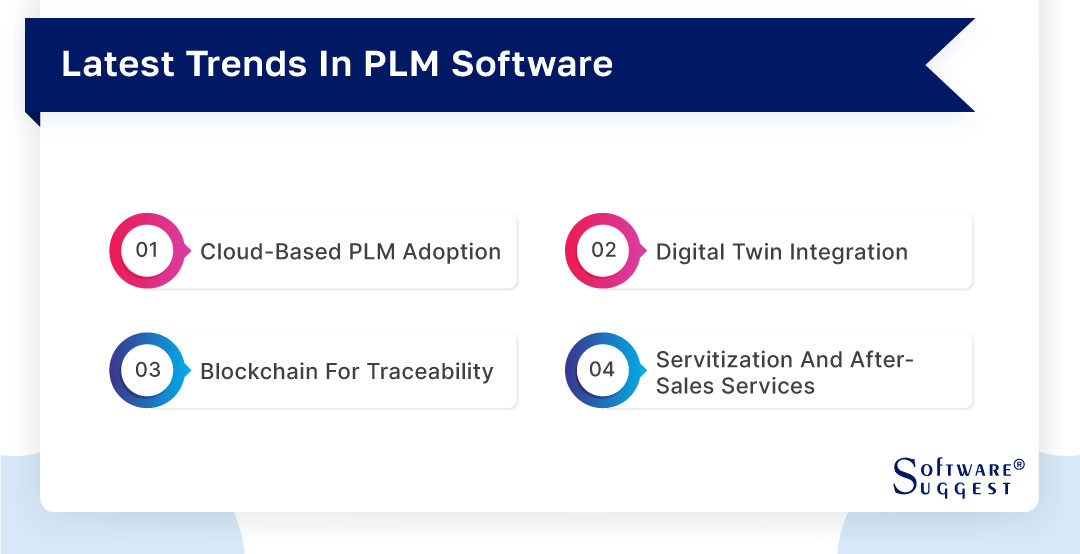
-
Cloud-based PLM adoption
As technology continues to evolve, there is a growing trend toward cloud-based PLM solutions. More accessibility, scalability, and flexibility are provided by cloud PLM. The impact of geographic barriers can be lessened by teams working together in real time from different places.
Additionally, cloud-based solutions make maintenance and updates simpler. Consequently, businesses can be guaranteed that they always have access to the newest features and security protocols.
-
Digital twin integration
Digital twin technology involves creating a virtual replica of a physical product, allowing for real-time monitoring and analysis. Integrating digital twin capabilities into PLM systems enables organizations to simulate and optimize product performance throughout its lifecycle.
This is especially helpful for the manufacturing and healthcare sectors. It is useful where the ability to predict and prevent issues can significantly impact efficiency and quality.
-
Blockchain for traceability
Blockchain technology is increasingly being explored for enhancing traceability in PLM. Blockchain offers a transparent and safe method for recording and validating transactions. Thus making it ideal for tracking the movement of products and components.
By integrating blockchain technology with PLM, data integrity may be strengthened, counterfeiting risk can be decreased, and supply chain visibility is increased overall.
-
Servitization and after-sales services
A notable trend in PLM is the shift toward servitization, where manufacturers transition from selling products to offering services. PLM systems are adapting to support this shift by incorporating features that enable organizations to manage after-sales services.
These can be maintenance, repairs, and upgrades. This trend aligns with the growing importance of creating ongoing value for customers beyond the initial product sale.
What Is The Cost Of A Product Lifecycle Management (PLM) Software?
The cost of product lifecycle management solutions is influenced by factors like company size, complexity, user count, features, and deployment method. Typically, prices range between $80 and $150 per user per month. Additional expenses may include implementation, training, and support fees.
Thus varying across vendors and company requirements. These factors collectively determine the overall investment necessary for leveraging PLM solutions tailored to a company's unique demands and operational scale.
Conclusion
In conclusion, navigating the dynamic landscape of product lifecycle management demands a strategic choice. This buyer guide has illuminated the top-tier PLM software, providing insights into features, scalability, and user experience. As you make your next purchase, consider the nuanced advantages each platform offers. Your selection should align with not just your current needs but future growth. Let this guide be your compass, steering you toward a seamless and future-ready PLM solution. Choose wisely and innovate confidently.
FAQs
No, ERP (Enterprise Resource Planning) is distinct from PLM (Product Lifecycle Management) software, although they can complement each other in business processes.
Yes, PLM software is often available in both on-premises and cloud-based versions, offering flexibility in deployment.
SAP is an ERP system focusing on business processes, while PLM is dedicated to managing a product's lifecycle, covering design, development, and manufacturing phases.
By Countries
By Cities
By Industries














